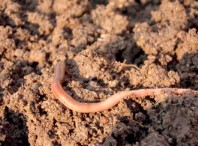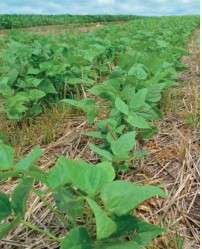Dr Harry Langford, Dr Jemma Taylor

Helping farmers to de-risk the changes associated with adopting regenerative agriculture practices could play a vital role in ensuring a sustainable future for farming. To successfully achieve this, the industry needs to demonstrate tangible outcomes and associated impact, supported by quantifiable metrics, but how? CHAP Innovation Network Lead, Dr Harry Langford and Research Associate, Dr Jemma Taylor, are part of a team that has developed a business case to explore just that.
Through CHAP’s New Innovations Programme, which brings together skilled practitioners and technical specialists to define critical realworld challenges, potential ideas for overcoming areas of market failure are scoped. From this, business cases are formulated with a view to overcoming a shared sector challenge, in this case, de-risking regenerative agriculture decisions.
Reporting on the business case, Dr Langford and Dr Taylor provide sector insight, share the proposed solution and draw in knowledge from industry advocates of regenerative agriculture.
What and why
Regenerative agriculture (regen ag) is a series of methodologies, associated products and technologies, that seek to improve and build agricultural soils by creating a self-nourishing ecological system to benefit both food production and the environment. The most widelysupported definition of regen ag comes from ‘The Carbon Underground ’ – “farming and grazing practices that, amongst other benefits, reverse climate change by rebuilding soil organic matter and restoring degraded soil biodiversity – resulting in both carbon drawdown and water cycle improvements”.
This is something to be taken seriously, as we consider the broader and future implications of current agricultural practises and what could take place to ensure a healthy and sustainable future food system. For context, the modern intensification of agriculture began in the 1960s with the Green Revolution, and has since led to a number of ecological concerns including soil degradation, water pollution and high greenhouse gas (GHGs) emissions.
These are detailed as –
• Agricultural soils are degrading at an alarmingly fast rate. 33% of UK soils are thought to be degraded, with 6 million hectares at risk of compaction or erosion. Yet despite it costing an estimated £1.2 billion per year to the UK economy, translating soils research and unpicking the complexity of soil health to apply this knowledge on farm remains challenging.
• 35% of surface water bodies and 31% of groundwater bodies fail to meet ‘good status’ (ecological & quantitative) as legislated by The Water Environment (Water Framework Directive) (England and Wales) Regulations 2017 . A quarter of this is correlated with agricultural activity, primarily through diffuse pollution and sediment deposition.
• UK agriculture is responsible for 10% of GHG emissions, with emissions of methane (56%) and nitrous oxide (31%) dominating. Through the NetZero policy, the UK government has committed to net zero GHG emissions for all sectors by 2050. This puts agriculture under pressure to reduce its emissions and remove, through sequestration, what it cannot reduce.
However, there is good news. Agriculture can be a ‘carbon sink’ due to the capture of carbon by plants and the sequestering of carbon into soil storage. This not only improves soil health and reduces water pollution, but is also a vital component of climate change mitigation.
Regen ag techniques enhance these natural processes by making them more effective. A key challenge is to better understand and measure these benefits, in order to accurately validate the sequestration. This will enhance the adoption of sustainable practice, as well as ultimately enabling revenue generation, either by public good delivery (via the upcoming Environmental Land Management Schemes) or through the carbon market. The latter could be an important emerging market to capture, as the price of carbon offsets in the EU Emissions Trading Scheme has doubled in the last year, from ~€28 to ~€56 per tonne.
We want to see what role CHAP could play in overcoming this challenge.
Analysing the market
Many farmers already practice a range of regen farming techniques in the UK and across the world. The beauty of the system is that it is a process of continuous improvement, so there are always entry points and next steps for those who engage with it. The greatest uptake country-wise so far has been in Australia, with Vietnam having the largest percentage change in land farmed regeneratively between 2017-2018 . The charity Regeneration International, which supports regen ag practice, currently has 391 partners, 13 of which are in the UK . There has also been an increase in academic research, with the number of papers mentioning the topic doubling between 2018 and 2019 .
Large companies such as PepsiCo, McCains and Danone are now pledging to support regen ag and encourage their supply farms to take up the practice. This not only benefits the environment, but could also potentially lead to a market advantage. The UK-led G7 Sustainable Supply Chain Initiative, including 22 leading food and agriculture companies such as Unilever and Sainsbury’s, also launched on 16th December 2021 with a focus on building better agricultural systems. Netflix also premiered a film by Kiss the Ground , an American charity advocating regen ag, bringing it firmly into the public eye.
Supporting regen farming practices further are decision support systems (DSS) and tools. Popular examples include:
• Cool Farm Tool – Online GHG, water and biodiversity calculator for farmers
• Agrecalc – Carbon calculator tool to monitor and reduce a farm’s carbon footprint
• RegenFARM Platform – Agri-tech platform enabling farmers to redesign food production by simulating regen ag interventions
• Farm Carbon Toolkit – Digital benchmarking tool for farmers to calculate carbon footprint for their farm.
Newly emerging tools extend this portfolio further and include AGREED, a platform to provide data-driven decision support around naturefriendly practices, and the Soilmentor Regen Platform, a benchmarking tool for farmers based upon 10 critical soil metrics. Companies committed to breaking into the carbon offset market in the UK and EU are doing so by establishing trading platforms to ease the process of converting carbon capturing activities into sellable assets. Those in the UK are being supported in these ventures through the new UK Land Carbon Registry, but this sector is still in its infancy.
The case for change
“We wondered, ‘if regenerative agriculture is so great, why aren’t more farmers switching to it? what’s holding them back?’ When we dug a bit further, we realised it was the perceived risk of transition without clear tangible benefits that stayed most hands. That’s actually good, because those barriers can be overcome with sound data and support.”
Kelly Price, CEO AGREED
To meet the demands of an estimated global population of 9-10 billion by 2050, food production will need to increase by 70% on the same or less agricultural land area. The “Driving Productivity Growth Together” report, shows that increased, and more efficient productivity is a key strategic outcome for the UK. The AHDB believes farmers and growers have the biggest part to play in meeting the UK productivity challenge. This increasing pressure on farmers to increase productivity is against a backdrop of tightening regulations, withdrawal and restriction of crop protection tools, rising resistance to existing pesticides and increasing demand for reduced input and impact on the environment. The case for change can be summarised in the following ‘problem statement’, that this business case is tasked with addressing.
Problem statement
“We need to measure, prove and demonstrate the tangible impacts of regenerative agriculture in order to de-risk change, drive adoption and create a new place for farming. There are not currently enough, sufficiently well-proven or locally-translatable, models for regenerative agriculture that truly balance yield, resilience, and carbon sequestration”

Regenerative agriculture – part of the solution
The use of regen ag leads to a number
of benefits –
• Building soil organic matter to improve water holding capacity & crop resilience, and reduce runoff & erosion.
• Improving soil microbiome to enhance plant nutrient uptake & help prime/protect plants against pests & disease.
• Enhance the sequestration of carbon into soil storage; helping address climate change & achieve the net zero target.
Further exploration is required to establish how carbon sequestration could most effectively be achieved, and whether it could provide an income stream as an investible natural capital product. The value of this opportunity is significant, as most other industrial sectors cannot act as a carbon sink. More broadly, there is good correlation between regen ag and improving the ‘ecosystem services’ provided by the soil: e.g. purifying water, cycling nutrients, sequestering carbon, regulating flooding, and providing food, fibre and fuel.
The recent rise in precision agriculture and associated monitoring and measuring technology brings further opportunity for regen farmers. The improvement in data granularity, if effectively harnessed, will provide more information on crops, the environment, carbon and local ecosystem services with which to make decisions. If regen farming is to be rewarded through external factors (e.g. the market or ELMs), this data could also provide evidence to support.
Sensors can now measure key soil health indicators, from simple indicators, such as pH and organic carbon content, to more complex, such as microbial diversity or volatile organic compound (VOC) signatures. Aerial or satellite imagery can measure crop health and predict both yield and nutrition requirements, and sensing, sampling and laboratory analyses can determine biodiversity, community structure and plant micronutrition. Despite these opportunities, there are still a number of barriers to the adoption and scale up of regen ag.
Barriers to overcome
During stakeholder workshops organised by CHAP as part of creating the business case, a number of barriers were outlined and confirmed:
• Risk Real and perceived risk from undertaking new practices with unknown and less predictable outcomes.
• Evidence Lack of robust data and evidence in a complex system.
• Diversity Heterogeneity of soil systems & discrete farm management plans. Hard to make certain practices work at individual farm or field level.
• Transition How to implement a successful transition period. Regen practice seeks to improve the biological system, which takes time.
• Reward Lack of incentive, reward & recognition for regen produced food.
• Confusion How parameters for regen ag compare to conservation agriculture, integrated farm management (IFM), etc.
• Mindset Resistance to change must be overcome – mindset and risk appetite.
• Integration Practices often only bring benefits when part of a full system. Need to combine factors to make a difference.
Solution – The Field Profiler

CHAP proposes the development of a ‘Field Profiler for Regenerative Agriculture’, in the form of a profiling tool which exploits best-in-class approaches to measurement and clustering, to deliver accurate and resonant profiles to support regen ag decisions. The primary purpose of this is to enable land managers to target multiple different objectives for their land, from yield improvement to carbon farming, by providing predictions of the likely outcomes of a management decision and insights into the possible pathways of delivering those outcomes. Its secondary purpose is to support the development of common metrics with which to benchmark regen and net zero agriculture. This would be done through the integration and effective use of existing data, as well as generating new data through sensor and in-field measurement of the environment in and around the crop at a sub-field level, to create a series of profiles that represent the diversity of fields under-going regen ag.
Long-term, it is hoped that this data could be used to define a ‘digital twin’ of the field, for real-time analysis and predictive insight. By focusing on improving measurement and insight, this solution provides a measurement protocol for, and benchmarks of, regenerative success, and provides the data to underpin improved scenario testing and simulation. It directly addresses the need to measure, prove and demonstrate the tangible impacts of regen ag to de-risk change and drive adoption. This is due to the profiles being scoped for individual fields rather than whole farms, allowing small-scale changes to be made with expected positive outcomes, so lowering entry barriers for uptake of regen ag practices.
The ‘Field Profiler’ was assessed as delivering the equal best economic return on public investment, despite being the highest cost. It substantially outperformed other assessed options for qualitative benefits (particularly in providing a clearer focus for research and practice). It is recognised that it carries a moderate level of risk, but this can be managed and mitigated through good sector relationships. CHAP is confident that it can successfully deliver the ‘Field Profiler’ as a solution to the current challenge, as it strongly aligns to its purpose, vision and strategy within the UK agri-tech sector.
With special thanks to CHAP’s partners and collaborators for enabling this report to be created.
enquiries@chap-solutions.co.uk
http://www.chap-solutions.co.uk/
1. The Carbon Underground Regenerative Agriculture definition paper https:/ secureservercdn.net/50.62.174.113/02f.e55.myftpupload.com/wpcontent/uploads/2017/02/Regen-Ag-Definition-7.27.17-1.pdf
2. https://www.legislation.gov.uk/uksi/2017/407/contents/made
3. Oxford Analytica (2020), “Regenerative agriculture needs public-private support”, Expert Briefings. https://doi.org/10.1108/OXAN-DB254346
4. https://regenerationinternational.org/our-network/
5. Newton P, Civita N, Frankel-Goldwater L, Bartel K and Johns C. (2020). What Is Regenerative Agriculture? A Review of Scholar and Practitioner Definitions Based on Processes and Outcomes. Frontiers in Sustainable Food Systems. 4:577723
6. https://kisstheground.com/ 7. ‘Driving Productivity Growth Together’, (AHDB, 2018)